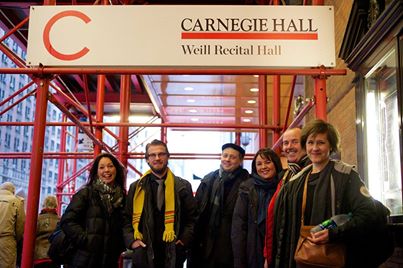Distinguished Concerts International New York (DCINY) Artists Series presents Nordic Voices in Review
Distinguished Concerts International New York (DCINY) Artists Series presents Nordic Voices Nordic Voices- Tone Braaten and Ingrid Hanken, soprano; Ebba Rydh, mezzo-soprano; Per Kristian Amundrøy, tenor; Frank Havrøy, baritone; Trond Olav Reinholdsten, bass Weill Recital Hall at Carnegie Hall; New York, NY February 2, 2014Scheduled the same evening as the Super Bowl, Nordic Voices appeared in concert at Weill Recital Hall. It was gratifying to see a packed house- an indication that there are people besides me who couldn’t care less about the other event taking place at the same time. Before I get to my review proper, I have an admission to make – I arrived at the concert late and missed the first four pieces. Although I do feel that my discussion of the remaining ten works will give a valid appraisal of the concert, my responsibility to the performers, presenters and other readers of this review impels me to let them know why I will not be discussing these works. I am reminded of a music critic whose “review” of a concert which he failed to attend was published in a major New York newspaper. Unfortunately for him, the concert never took place, having been cancelled at the very last moment.
I arrived during spoken commentary from the stage introducing two works from György Ligeti’s “Nonsense Madrigals,” a collection of settings from “Alice in Wonderland.” As no printed texts and translations were distributed, many of the tonight’s works were introduced in this manner. Although readers of my reviews know that I like to follow the texts/translations word by word, Nordic Voices and many other performers have begun to realize that very few people do. Tonight’s introductions couldn’t have been better – they were enunciated well enough to be heard in the back row of the hall, were informative and witty, and helped to create a warm relationship between the performers and their audience. The performances were all one could ask for, as the extended vocal techniques and rhythmic complexities were handled with consummate skill and ease. This was the case in all of the more experimental works which were to follow. I am confident this was so in the works by Lasse Thorsten and Bjarne Sløgedal which opened the program.
The first half ended with a spirited rendition of “Les chants des oiseaux,” a chanson by the Renaissance composer Clément Janequin. Nordic Voices also performed this work on a 2004 concert which I reviewed for this publication. In that review, I chided them for not following “the rules of musica ficta [which] dictate that leading tones in cadences are always sung a half step below the tonic, even when they appear otherwise in the printed score.” I am sorry to say that they did not take this to heart and made the same error on tonight’s concert. Saddened might be a better word than sorry, for this is not a matter of interpretation, and is similar to singing the same wrong note each time a passage is repeated in the course of a composition.
The second half began with an exquisite performance of the motet “Ecclesie militantis” by the Early Renaissance composer Guillaume Dufay. The pure non-vibrato sound of the female singers, the perfect intonation, the rhythmic clarity, and the beautifully shaped polyphonic lines all made me wish I had heard their performance of the two Renaissance motets by Thomás Luis de Victoria which I missed on the first half. What is more, Nordic Voices did follow the rules of musica ficta during the Dufay motet, even singing the wild double-leading-tone cadence at the end. I wonder what did they do with the Victoria?
A series of contrasting works followed. First the ethereal simplicity of “Predicasti,” a Medieval chant. Then the fiendishly difficult “O Magnum mysterium” by Henrick Ødegaard, during which Nordic Voices “pulled out all the stops” and gave us a demonstration of extended vocal techniques which boggled the mind. One is just amazed that the human voice can create all those sounds. This serious work was followed by three movements from Goffredo Petrassi’s whimsical “Nonsense,” settings of limericks by Edward Lear. The lighthearted subject matter and matching theatrical performance tend to hide that fact that these also very difficult pieces which Nordic Singers performed with consummate skill and ease. During Maurice Ravel’s chanson “Trois beaux oiseaux du Paradis,” we all could luxuriate in Nordic Voices’ beautiful sound.
A work by Frank Havrøy, Nordic Voices’ baritone, concluded the concert. “Bysjan, bysjan lite bån” (“Hush, hush, little child”) showcases two qualities which make Nordic Voices a unique ensemble – their skill with extended vocal techniques and their beautiful ensemble sound. Without spoken comment, the singers moved off the stage, the women to the aisle on the audience’s left, the men to the aisle on the right. The work’s long, soft wordless opening featured extended vocal techniques. It was followed by a most beautiful setting of what I took to be a Norwegian folk song and another beautiful folksong setting served as the concert’s gentle encore.

